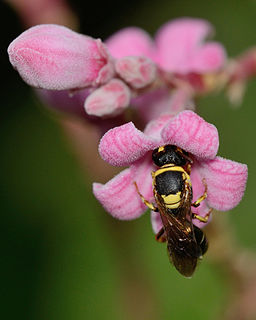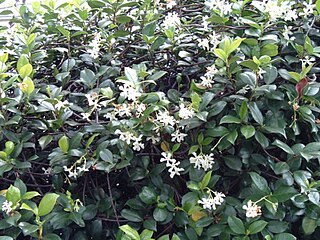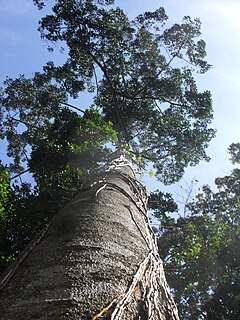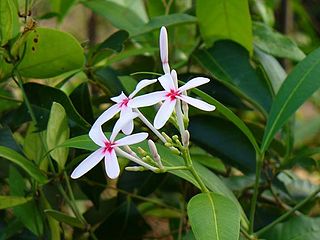
Gentianales is an order of flowering plants, included within the asterid clade of eudicots. It comprises more than 16,000 species in about 1,138 genera in 5 families. More than 80% of the species in this order belong to the Rubiaceae family.

The Nymphalidae are the largest family of butterflies with more than 6,000 species distributed throughout most of the world, belonging to the superfamily Papilionoidea. These are usually medium-sized to large butterflies. Most species have a reduced pair of forelegs and many hold their colourful wings flat when resting. They are also called brush-footed butterflies or four-footed butterflies, because they are known to stand on only four legs while the other two are curled up; in some species, these forelegs have a brush-like set of hairs, which gives this family its other common name. Many species are brightly coloured and include popular species such as the emperors, monarch butterfly, admirals, tortoiseshells, and fritillaries. However, the under wings are, in contrast, often dull and in some species look remarkably like dead leaves, or are much paler, producing a cryptic effect that helps the butterflies blend into their surroundings.

According to APG II, the Asclepiadaceae, commonly known as milkweed family, is a former plant family now treated as a subfamily in the Apocynaceae.

Alyxia is an Australasian genus of flowering plant in the dogbane family, Apocynaceae. It contains at present 106 species, but Alyxia stellata and A. tisserantii are very variable, might be cryptic species complexes, and are need of further study. It consists of shrubby, climbing or scrambling plants. This genus occurs in China, the Himalayas, Southeast Asia, Malaysia, Australia, New Caledonia and the Pacific Islands. There are 14 species in Australia, 21 in New Caledonia and 7 in the other Pacific Islands, including Hawaiʻi.

Dogbane, Dog-bane, Dog's bane, and other variations, some of them regional and some transient, are names for certain plants that are reputed to kill or repel dogs; "bane" literally means "death".

TrachelospermumStar Jasmine, Confederate Jasmine, is a genus of evergreen woody vines in the dogbane family Apocynaceae, first described as a genus in 1851. All species are native to southern and eastern Asia.

The Entelegynae or entelegynes are a subgroup of araneomorph spiders, the largest of the two main groups into which the araneomorphs were traditionally divided. Females have a genital plate (epigynum) and a "flow through" fertilization system; males have complex palpal bulbs. Molecular phylogenetic studies have supported the monophyly of Entelegynae.

Apocynoideae is a subfamily of the flowering plant family Apocynaceae. It contains about 78 genera with roughly 860 species. Several species are of pharmacological interest. Important genera include Nerium.

Hancornia is a genus of flowering plant in the family Apocynaceae, first described as a genus in 1812. It is native to South America. It contains only one known species, Hancornia speciosa, commonly called mangabeira, which produces fruits known as mangabas.

Aspidosperma megalocarpon is a species of plant in the Apocynaceae family. It can be found in Belize, Colombia, Ecuador, El Salvador, Guatemala, Honduras, Mexico, Nicaragua, Panama, Suriname, Venezuela, and NW Brazil.
- Aspidosperma megalocarpon subsp. curranii(Standl.) Marc.-Ferr. - Panama, Colombia
- Aspidosperma megalocarpon subsp. megalocarpon - from Veracruz to NW Brazil

Kopsia is a genus of plant in family Apocynaceae first described as a genus in 1823. Kopsia is native to China, Southeast Asia, Australia, and various islands of the western Pacific.
- Kopsia angustipetalaKerr - Thailand, Laos
- Kopsia arboreaBlume - S China, SE Asia, N Australia, Andaman & Nicobar Is
- Kopsia dasyrachisRidl. - Sabah
- Kopsia deverreiL.Allorge - Johor
- Kopsia flavidaBlume - Philippines, Maluku, New Guinea, Solomon Is, Vanuatu, Micronesia
- Kopsia fruticosa(Roxb.) A.DC. - Myanmar, Andaman Is
- Kopsia grandifoliaD.J.Middleton - Johor, Anambas Is
- Kopsia griffithiiKing & Gamble - W Malaysia
- Kopsia hainanensisTsiang - Hainan
- Kopsia harmandianaPierre ex Pit. - Vietnam
- Kopsia lapidilectaSleesen - Natuna Is
- Kopsia larutensisKing & Gamble - W Malaysia
- Kopsia macrophyllaHook.f. - W Malaysia
- Kopsia paucifloraHook.f. - Indochina, W Malaysia, Sumatra
- Kopsia profundaKing & Gamble - W Malaysia
- Kopsia rajangensisD.J.Middleton - Sarawak
- Kopsia roseaD.J.Middleton - S Thailand, Kelantan
- Kopsia singapurensisRidl. - Singapore, W Malaysia
- Kopsia sleesianaMarkgraf - Sarawak
- Kopsia sumatranaD.J.Middleton - Sumatra
- Kopsia tenuisLeenh. & Steenis - Sarawak
- Kopsia teoiL.Allorge - W Malaysia
- Kopsia tonkinensisPit. - Vietnam
- Kopsia vidaliiD.J.Middleton - Vietnam

Dyera is a genus of tropical trees up to 80 m in height. They are in family Apocynaceae, native to southeast Asia. It was first described as a genus in 1882.

Holarrhena pubescens is a species of flowering plant in the Apocynaceae family. It is native to central and southern Africa, the Indian Subcontinent, Indochina, and parts of China. In Cambodia, it is called /tɨk dɑh kʰlaː thɔm/ ទឹកដោះខ្លាធំ big tiger milk or /kʰlaɛɲ kŭəŋ/ ខ្លែងគង់ invulnerable kite.
Haplophyton is a genus of plants in the family Apocynaceae, first described in 1844. It is native to the southwestern United States, Mexico, Cuba, and Guatemala. It is a suffrutescent herb with alternative leaves and showy colorful flowers.
Eucorymbia is a genus of flowering plants in the family Apocynaceae, first described as a genus in 1905. It contains only one known species, Eucorymbia alba, native to Borneo, Sumatra, and peninsular Malaysia.
Mortoniella is a genus of flowering plants in the family Apocynaceae, first described as a genus in 1939. It contains only one known species, Mortoniella pittieri, native to Central America.
Vallariopsis is a genus of flowering plants in the family Apocynaceae, first described as a genus in 1936. It contains only one known species, Vallariopsis lancifolia, native to Peninsular Malaysia, Borneo, and Sumatra.
Conomitra is the scientific name of two genera of organisms and may refer to:














